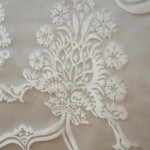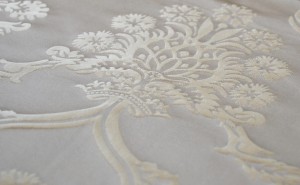
One of the aims of IMAGO ANTIQUA Cultural Association is “enabling sinergies between operators provided with widely recognized abilities in the Re-enactment field, giving visibility to vocations and remarkable personal projects closely related to the study of 15th century history”.
Following this approach, we’d like to bring to your attention a project encouraged by a follower of our association, Mr. Renzo Semprini, a longtime re-enactor born in Emilia-Romagna and now an adopted Florentine.
For several months Mr. Semprini has been in touch with the FONDAZIONE LISIO (Lisio Foundation), headquartered in Florence, trying to give birth to a super-detailed repro of an original Italian silk textile of late 15th century.
We are talking about the damask of a doublet which was tailored more than 530 years ago, discovered on the mortal remains of a well-known Campanian “condottiere”, named Diego Cavaniglia (1453-1481).
But let’s take this step by step…
This first Lisio lab arose in 1906 thanks to its founder Giuseppe, with the aim of keeping alive the ancient traditional Italian weaving, which reached a leading position in the Middle Ages and the Renaissance period; the Foundation was established much later, in 1971, with a view to supporting the enterprise both financially and in terms of research.
Lisio is still at the top of a niche manufactoring production, boasting patiently handmande crafts achieved through ancient looms, using silk as well as gold and silver yarns.
FONDAZIONE “ARTE DELLA SETA LISIO”
Via B. Fortini 143 – 50125 Firenze
TEL ++39 055 6801340 / FAX ++39 055 680436
EMAIL: info@fondazionelisio.org
Sito web – Lingua italiana
Website – English language
At the request of Mr. Semprini, the Lisio Foundation has carried out, for the first time and all the way esclusively, a special research focused on reproducing with a mechanical loom the antique pattern of a 100% silk damask, stubbornly sticking to the historical counterpart for an excellent quality output.
The abovementioned reasearch, as well as the textile testing, proved to be fully successful.
Soon after that, despite the complex economic situation of the last years, the Foundation started a project which specifically targets the “Living History” world, evaluating the possibility of weaving on mechanical looms accurate replicas of genuine late medieval textiles, both destined to museum displays as well as to the more demanding Re-enactors.
As a “pilot product” they so replicated the SILK DAMASK of Don Diego Cavaniglia’s funeral doublet, in its original colour, that is “ivory design on ivory background”. Here follows a picture of the finding:

DIEGO CAVANIGLIA’S DOUBLET (courtesy of Paola Fabbri)
Here you can see some shots of the finished sample:







After this thriving achievement, Lisio is now ready to investigate the market interest in this particular kind of complex textiles, custom-made and exclusively made on commission.
In this case, the running goal, shared and supported by IMAGO ANTIQUA Cultural Association, is gathering a level of demand proving to be enough to start a limited length production of “Cavaniglia textile”, keeping technical characteristics as close as possible to those of the original, except in color. More specifically:
Type of textile: silk damask
Textile height: 1.40 meters (equal to 140 cm)
Textile colours: ivory design on green background
(IMPORTANT – YOU CAN’T REQUEST DIFFERENT COLOURS!)
Goal: minimum production of 30 meters
Selling price = 170 Euros per 1 meter (inclusive of Italian taxation)
Minimum order quantity per single buyer: 1 meter
In order to start the production, the firm is so trying to gather a number of buyers (re-enactors, amateurs, etc.) capable, all together considered, to guarantee at least the funding needed to cover the fixed manufacturing costs of the whole minimum length of 30 meters.
If you are willing to contribute to this aim, registering for the purchase of nr. 1 or more meters of “Cavaniglia textile”, only available with an ivory design on a green background, you are kindly invited to communicate your interest sending an email to Mr. Renzo Semprini, who serves as a point of contact with the Lisio Foundation: renzosempro@gmail.com
** Disclaimer **
There’s one thing we’d like to make perfectly clear: IMAGO ANTIQUA Cult. Ass. will not derive any gain from the aforementioned project as it has got NO relationship with the business run by the Lisio Foundation, nor holds any interest in Mr. Renzo Semprini’s sphere of action. In a nutshell, the only reason urging us to contribute to the success of this challange is the wish that, in a hopefully not too distant future, all historical re-enactors can benefit from real textile repros, without any compromise, fully suitable to the tailoring of artistocratic garments and clothing accessories because totally tracing the features shown by late medieval products.
LEGGI QUESTO ARTICOLO IN ITALIANO: CLICCA QUI
























